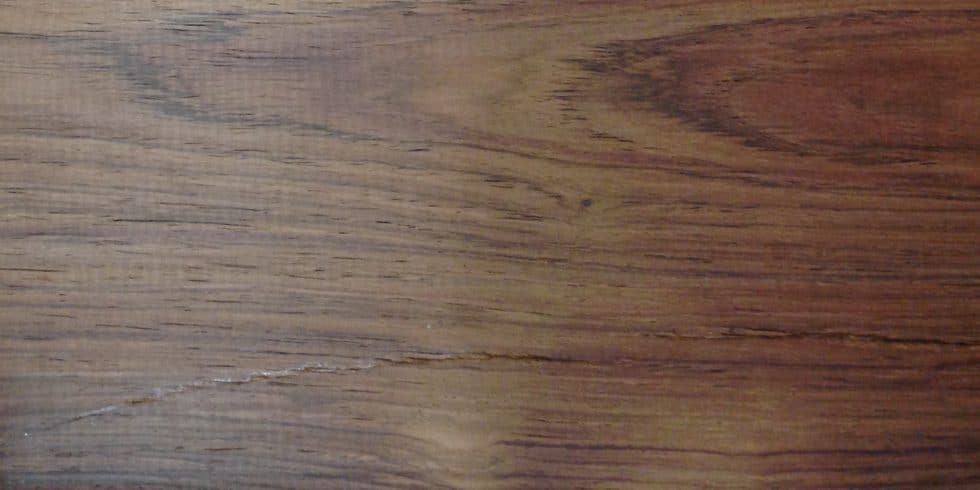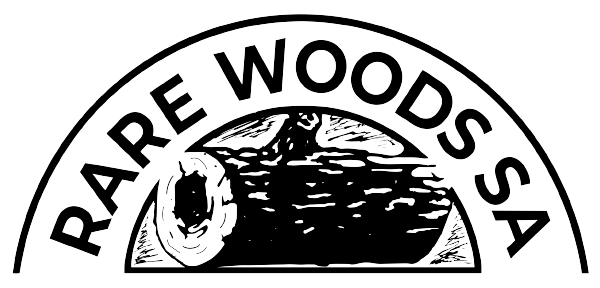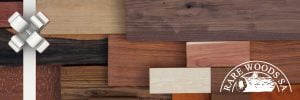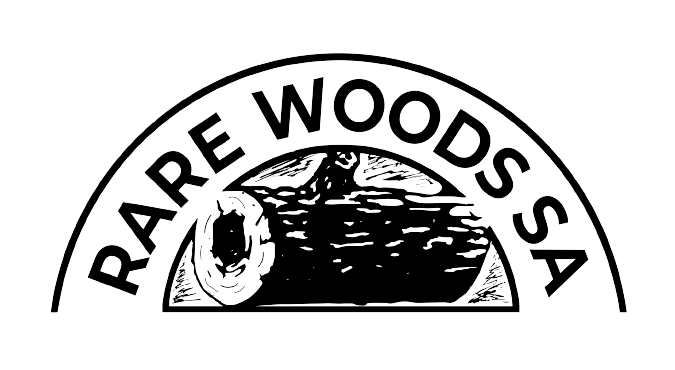Rosewood – Honduras
Quick Look

Denser than East Indian Rosewood, Honduran Rosewood is well known for being the preferred wood for Marimba bars, with its ringing, well-rounded tonal properties. It compares well to Brazilian Rosewood (many claim it actually superior), producing a well-balanced acoustic guitar, with great projection and strong lows and highs. (In fact, during the ’50?s and ’60?s, the great flamenco guitar crafters considered it to be the only acceptable substitute to Brazilian Rosewood.)
Honduran Rosewood’s grain lines are unusually tight and straight (though sometimes wavy or interlocked). The color ranges from a medium tan to a brownish brick red color, medium brown (sometimes with a purplish tint) or even a medium to dark burgundy, with occasional dark brown or black ink lines. Due to the wood’s density and high oil content, it can be difficult to cut, machine and glue. Its texture can range from fine to medium; (not unlike Braz Rw) it is porous, and those pores are usually medium- to large-sized. As would be expected — given its oily nature — the wood has a rich natural luster.
Listed in CITES Appendix II, but not on the IUCN Red List of Threatened Species; part of the Dalbergia -genus worldwide exportation ban.
Why We Love This Wood
Honduran Rosewood has grown difficult to obtain in recent years, due to a poaching epidemic in Belize which victimized the species in 2011 and 2012. Despite a wane in its supply lines, demand for the wood remains constant.
Every major source we could find were unanimous in listing "2200 lbf" as the Janka Hardness rating for this wood, but we consider this figure to be very suspect. Most knowledgeable sources compare its weight and density to Brazilian Rosewood. The same sources list Bocote's Janka Hardness at 2200 lbf, also, and the Hon Rw examples we have handled are far more dense than any Bocote. (Some darker examples were more along the lines of a Cocobolo-type density.)
Search With Filters
Other Species
Durable and relatively affordable, European Chestnut is a popular cladding species in Europe. With looks similar to Oak and Ash, we are sure you will love the appearance of Sweet Chestnut. Grain can be interlocked, but Chestnut is still relatively easy to work. It can split relatively easily, so pre-drilling is essential.
This is a new species for us here at Rare Woods and a first for South Africa. We are delighted with what arrived and can’t wait to get it into some of your projects.
Detail
Common Uses
Longhi is an African wood with similar working properties to its more well-known cousin, Anegre. Its color varies from a greyish-white to beige to pinkish-brown color, which slightly darkens with age and UV-ray exposure. Its generally light appearance makes sapwood difficult to distinguish. Its grains are typical straight (though occasionally interlocked) and its texture ranges between fine and medium-fine. It can sometimes possess mottled or subtle tiger-striped figuring.
The wood must be carefully dried, as it is susceptible to fungus. It is considered to be moderately durable, and moderately stable. Longhi has a solid strength-to-weight ratio, which makes it a popular choice for flooring and decking.
cabinetry, decking, flooring, furniture
Detail
Common Uses
“Roasting” Flame Birch involves gradually heating the wood up to temperatures of greater than 160 degrees celcius in special heat chambers made of stainless steel under anoxic conditions. The heat removes organic compounds from the wood cells, changing both the physical and chemical make-up of the wood. The process is natural and chemical free. It darkens the wood to a beautiful rich chocolatey brown color whilst still showing the gorgeous grain and figure of the underlying wood.
The thermally modified wood is more dimensionally stable, but the process does reduce bending strength and make the wood a little more brittle. This makes it chip a little easier than the un-modified lumber. The brittleness makes it less suitable for intricate cabinetry, but it is still an excellent choice for less intricate items such as floors, tops, panels, cladding etc.
Extra care needs to be taken when finishing thermally modified wood, as the “bone dry” wood has a tendency to “suck in” much of what is given to it. Our in-house woodworking specialist has had excellent results with Osmo PolyX. He suggests a thicker finish will work better.
flooring, interior panelling
Detail
Common Uses
This Malaysian species is a medium weight timber suitable for light structural purposes. It is a popular joinery timber and it machines easily and finishes well.
furniture, joinery
Detail
Common Uses
Indigenous to the tropical regions of East Africa and West Africa, as far south as Angola.¬† Anegre has been used primarily as an interior wood; it is decidedly non-durable, and thus not recommended for outdoor applications. The wood’s aesthetics can vary greatly, as Anegre is comprised of three separate species within the Pouteria genus. Its colors can range from pale yellowish to orangish-brown wood, to a pale pinkish-brown, sometimes with additional highlight coloration. Anegre typically darkens to a golden-to reddish brown over time, with repeated UV ray exposure. The heartwood and sapwood of Anegre are usually not distinguishable from each other.
Anegre has a medium texture with closed pores similar to Maple.  The species is easy to work with both hand and power tools.
Examples can be quite beautiful — and sometimes stunning, with curly and mottled figuring being not uncommon. Its hues tend to be generally pastel in nature, so it makes a very complimentary, aesthetically unimposing wood for a variety of interior applications. Grains are typically straight but can occasionally be interlocked. Its texture is medium and it has a nice natural luster.
boatbuilding, cabinetry, carpentry, construction, veneer
Detail
Common Uses
Masur Birch (also known as Karelian Birch) is not a species in of itself, but rather a particular grain figure that occurs in various species of European Birch. The result is a beautiful marble like figure – a mix between burl and birdseye.
The cause of this figure is uncertain. Some say that it comes from a tree’s reaction to invasion by the larvae of the Agromyzia carbonara beetle, but the general opinion seems to be that it is hereditary, classifying the name of the variant as Betula pendula var. Carelica. Regardless of the exact origin of the figure, it provides us with stunning and unique looking lumber, just begging to be showcased in some fine woodworking. It is most commonly used in accent details, turned objects, knife handles and other small specialty items.
Veneers of Masur Birch are rotary cut (like Birdseye Maple) to ensure the best figure is extracted for the veneer.
fine furniture, knife handles, specialty items, turnings, veneer


